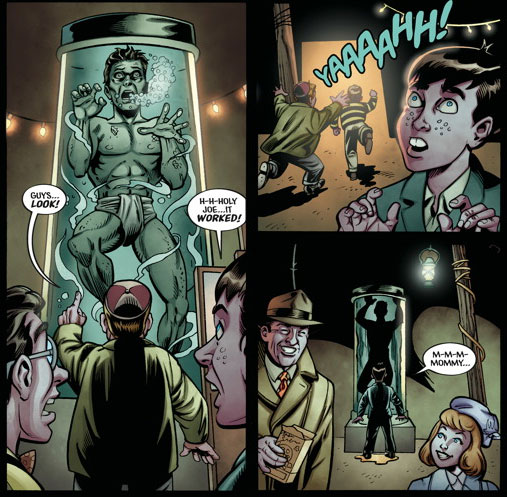Bill Morrison was born in 1959 and grew up in Lincoln Park, near Detroit, Michigan. He learned drawing from his older sister, Sue. Among his main graphic influences in the field of high art were Salvador Dalí, M.C. Escher, Alphonse Mucha, John Singer Sargent and Norm Saunders, and in terms of comic book art, Neal Adams. Sergio Aragonés. Matt Baker, Robert Crumb, Dan De Carlo, Will Eisner, Lee Elias, Bob Oksner, Dick Sprang, Jim Steranko, Wallace Wood and Bernie Wrightson. His favorite animator is Tex Avery. Morrison is also a lifelong collector of Batman-related merchandise.
Morrison studied at the College for Creative Studies in Detroit, graduating in 1981. He began his career as a technical illustrator in the Detroit automotive sector., working for Artech, Inc. Aspiring a more creative utilization of his art skills, he moved to California. Between 1982 and 1986, he illustrated film posters for B.D. Fox and Friends Advertising, where he first met Matt Groening, who worked as a freelance writer there. B.D. Fox was a boutique ad agency for the entertainment industry, where Mili Smythe was art director. In 1986, he worked for David Willardson's illustration studio Willardson & Associates, making advertising art for Nestles Quick, Maxell Tape,... Morrison's most notable endeavor were film posters. Between 1987 and 1990, he designed posters for Disney films, including 'Oliver & Co.', 'The Little Mermaid' and 'The Prince and the Pauper', but also Don Bluth's 'The Land Before Time' and live-action horror movies like 'The Return of the Living Dead' (1985), 'House' (1985) and 'Blood Diner' (1987).
'The Simpsons' - 'Bart Simpson's Treehouse of Horror' and 'Roswell. Little Green Man'.
By 1990, Morrison started his longtime association with Matt Groening, becoming an art director for merchandising related to Groening's hit TV series 'The Simpsons'. He created art for T-shirts, posters, calendars, books, video games, DVD covers,... and also developed a style guide for companies who license 'The Simpsons' brand. Morrison designed the "crowd" posters featuring all the main characters, side characters and notable one-shot characters featured on 'The Simpsons'. He also designed the album cover of 'The Yellow Album' (1997), an album with original songs sang by 'The Simpsons' voice actors, in character. The sleeve is a parody of The Beatles' 'Sgt. Pepper's Lonely Hearts Club Band'. Morrison initially also made merchandising art for other animated shows produced by Klasky Csupo, like 'Rugrats'.
In April 1991, a 'Simpsons' comics series was launched under the title 'Simpsons Illustrated'. All ten issues sold well and from February 1993 on, Morrison, Groening and editor Steve Vance developed it into a comic book, 'Simpsons Comics and Stories'. In November 1993, they established their own comic book publishing company: Bongo Comics, named after Bongo the Rabbit from Groening's 'Life in Hell'. Steve Vance was editor, his wife Cindy colorist and letterer. In 1994, Vance left and Morrison succeeded him as creative director (editor/art director), scriptwriter, inker, art director and main artist. Morrison also designed two comic reader apps, 'The Simpsons Store' and 'Futuramaland Comic Reader'.
In 'The Simpsons' episode 'Three Men and a Comic Book' (1991), the character Otto Mann talks about a self-made comic book, 'Busman', in which a bus driver (who is a muscular version of himself) fights vampires in a post-apocalyptic world. In Simpsons Comics issue #4 (May 1994), Steve Vance (writing) and Bill Morrison (comics) worked this idea out into an actual short story, 'The Gnarly Adventures of Busman'.
'Dead Vengeance'. #1
Morrison additionally created some comic titles of his own for Bongo Comics, such as 'Roswell - Little Green Man', 'Heroes Anonymous' and 'Lady Robotika'. 'Roswell, Little Green Man' (1996) is set in the 1950s, based on science fiction B-movie clichés. Morrison eventually ended his personal comics in 1999, when Groening's upcoming new animated series, 'Futurama', took up most of his time. Between 1998 and 2003, Morrison was art director for 'Futurama', co-designing several of the side characters, based on Groening's initial designs.
Morrison's six-issue mini-series 'Heroes Anonymous' (2000) for Bongo Comics revolved around a support group for superheroes. Morrison was assisted by editorial assistant Scott Gimple. Together they developed it into a script for a pilot episode, intended to be broadcast on the SyFy Channel. But they eventually abandoned the project when network executives forced them to make too many changes. Together with Jane Wiedlin, co-founder of the rock band The Go-Go's, Morrison made a comic book, 'Lady Robotika' (Image, 2010), starring Wiedlin as a cyborg space hero. In 2015, Morrison launched 'Dead Vengeance', his own creation for Dark Horse Comics. The plot, set in 1940s Detroit, pays homage to pulp comics.
Between 2015 and 2019, Morrison was president of the National Cartoonist Society.
Between May 2018 and March 2019, Morrison was the new chief editor of Mad Magazine. His term coincided with Mad's office moving away from New York City and settling down in Los Angeles. In 2018, Dark Horse Comics commissioned him to make a graphic novel, 'All You Nerd Is Love: A Yellow Submarine Puzzle Book', to celebrate the 50th anniversary of the Beatles animated feature 'Yellow Submarine', directed by George Dunning.
Morrison wrote the book 'Innocence and Seduction. The Art of Dan DeCarlo' (Fantagraphics, 2001), about one of his favorite comic artists, Dan De Carlo.
In 2024, Morrison wrote the script for an upcoming animated feature starring Pieter De Poortere's character Boerke (known as 'Dickie' in English).
Bill Morrison received the Eisner Award for Simpsons Comics (2000), 'The Amazing Colossal Homer' (1994) and the 'Radioactive Man' comics.







